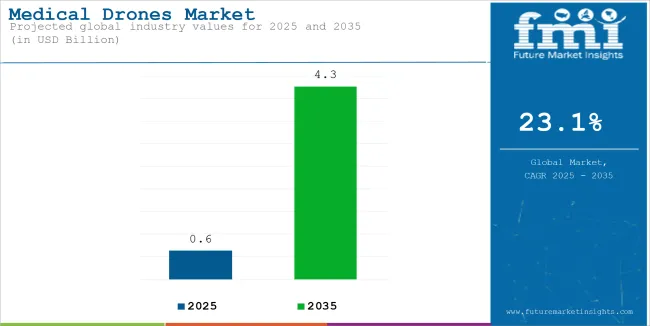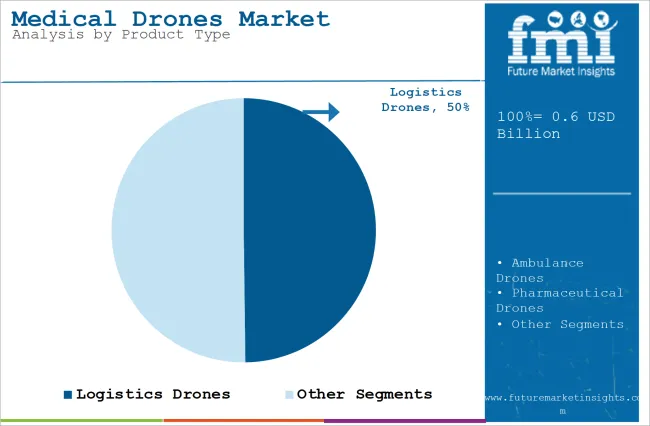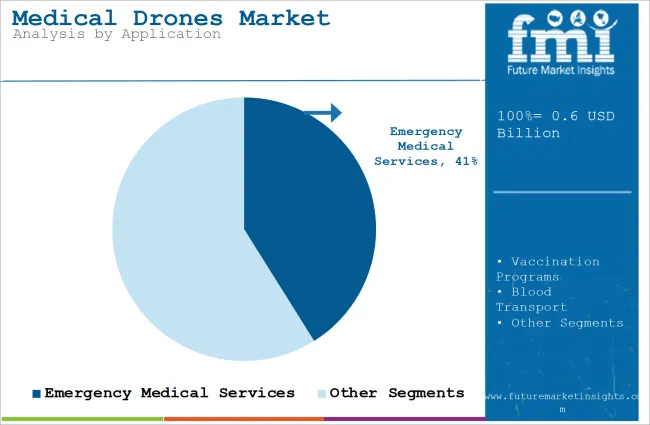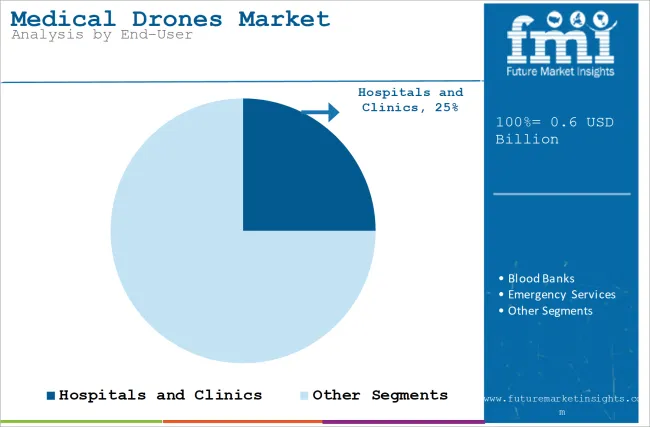The medical drones market is estimated to reach USD 0.63 billion in 2025. It is estimated to rise at a CAGR of 23.1% during the assessment period 2025 to 2035 and get a value of USD 4.26 billion by 2035.

| Attributes | Description |
|---|---|
| Estimated Medical Drones Market Size (2025E) | USD 0.63 billion |
| Projected Medical Drones Market Value (2035F) | USD 4.26 billion |
| Value-based CAGR (2025 to 2035) | 23.1% |
Medical drones mean the drones used for the timely delivery of healthcare supplies. The growing demand for faster and more efficient healthcare delivery, particularly in underserved and remote areas, is driving significant growth in the medical drones market.
This drone system ensures the timely delivery of life-saving supplies including antivenoms, blood, and vaccines to hospitals and clinics in rural regions. It is evolving in several developing regions of the world including Europe, North America, and others where healthcare infrastructure is strong.
Nations with poor road infrastructure, including parts of Africa, for example, Tanzania, Rwanda, and Ghana have seen a great demand for medical drones. In these areas, drones are crucial for delivering blood supplies, medications, and vaccines to rural clinics.
Additionally, many island countries such as Indonesia and the Philippines also witness higher product uptake for logistics. Moreover, during natural disasters such as earthquakes or floods, drones become critical for reaching affected areas. The product also has a heightened demand in nations highly susceptible to frequent disasters, such as Indonesia, Japan, and the Philippines.
Furthermore, amid the COVID-19 pandemic, drones gained interest for the transportation of vaccines, PPE, and test samples to minimize risk exposure while managing logistics. Moreover, drones were used by governments and NGOs in areas, including Southeast Asia and India to mitigate the risk of COVID-19 infections.
Moreover, perishable medical supplies such as vaccines require strict temperature control during transportation. Many organizations and governments are actively exploring the use of medical drones to expand healthcare access in regions with poor road infrastructure.
In nations such as Switzerland, the USA, and Germany, the demand is rising but the emphasis is more on niche applications such as inter-hospital, delivery, defibrillator, and organ transportation logistics. Despite a robust healthcare system, the testing and scaling process of drones is slow in these nations.
Furthermore, nations which are actively investing in healthcare technology, such as the UAE, South Korea, and Japan, consider drones as part of their smart healthcare ecosystems. They also emphasize pilots and testing, which hampers current adoption rates.
Present growth in drone technology, including decreased flight range, payload capacity, and improved navigation systems, is rising the capabilities and applications of medical drones.
Additionally, drones are being designed with larger payloads, allowing them to carry heavy medical goods, such as organs for transplantation. This is crucial for increasing the scope of medical deliveries. Moreover, drones are equipped with sophisticated sensors and GPS systems, allowing them to navigate complex environments and land precisely at designated locations.
Furthermore, Beyond Visual Line of Sight (BLVOS) operations technology allows drones to operate autonomously over longer distances, expanding their reach and operational flexibility.
Deployment with Telemedicine in Diagnostics
Medical drones are being integrated with cameras and communication devices to help telemedicine consultants in remote areas. For example, a patient in a rural village can get diagnostic equipment delivered by a drone and consult a doctor via a live video feed.
Drones are being intended to carry heavier and more diverse medical supplies, such as larger equipment and more fragile items, and innovations such as tethered drones, drone-launched parachutes, and specialized landing instruments are being developed to ensure safe and precise delivery of medical supplies in various settings.
Additionally, stronger materials are enabling drones to carry heavier payloads, such as larger medical equipment, blood products, and organs for transplantation. This improves the range of medical supplies that can be delivered by drone, improving the overall effectiveness of these systems.
Additionally, improved autonomous delivery capabilities, battery life, range, and AI-driven navigation systems are boosting the functionalities of medical drones. These improvements make them feasible for large-scale healthcare systems. Moreover, deployment with the blockchain and Internet of Things ensures that medical deliveries are tamper-proof, traceable, and safe.
Furthermore, in urban areas with heavy traffic, drones are being used to create aerial healthcare corridors. For instance, Matternet drones are being deployed in Switzerland for the transformation of medical samples in hospitals, which decreases delays.
Furthermore, drones are being more cost-effective for last-mile delivery in healthcare. They also help save costs related to maintaining large fleets of ground logistics or ambulances in rural regions.
High Cost May Hamper Adoption
Despite a host of benefits provided by medical drones, they incur a high cost of manufacturing. This prohibitive cost makes them out of reach for many healthcare institutions operating in rural locations of the world. Additionally, these products must comply with aviation guidelines, which is a major hurdle for the adoption of the product. Moreover, specialized licenses also add to the financial burden of many medical drone manufacturers.
High Applications in Urgent Delivery to Foster Logistics Drones Segment Expansion

| Attributes | Details |
|---|---|
| Top Product Type | Logistics Drones |
| Market Share in 2025 | 49.8% |
Based on product type, the medical drones market is divided into logistics drones, ambulance drones, pharmaceutical drones, and blood transport drones. The logistics drones segment held a 49.8% market share in 2024. Medical drones have high applications in the urgent delivery of medical supplies.
They also improve logistics by enabling more dependent and targeted delivery of medical products. Moreover, traditional logistics system often seems not feasible in instances of natural calamities such as floods and earthquakes. In this regard, medical drones help streamline the logistics processes by ensuring timely deliveries.
Surging Demand in Emergency Medical Services to Lead to Uptake

| Attributes | Details |
|---|---|
| Top Application Type | Emergency Medical Services |
| Market Share in 2025 | 41.1% |
Based on application the market is divided into emergency medical services, vaccination programs, blood transport, and organ transplantation. The emergency medical services segment held 41.1% market share in 2024.
Moreover, fast delivery of important supplies can mean the difference between death and life in emergencies. They decrease the logistical burdens on stretched emergency services, ensuring more efficient resource allocation. The surging demand for medical drones in emergency medical services is escalating segment expansion.
Heavy Government Investment in Construction of Hospitals and Clinics to Boost Demand

In terms of end-user, the market is classified into blood banks, government and humanitarian organizations, hospitals and clinics, and emergency services. The growing healthcare infrastructure in developing and developed regions globally is aiding the adoption of medical drones in hospitals and clinics. Moreover, governments are heavily investing in the establishment of these healthcare facilities to ensure high-quality care.
India
The market is expected to grow at 31.2% CAGR during the forecast period. Overcoming environmental challenges, improving access to healthcare, and disaster relief is the prime focus of Indian government in healthcare delivery. The country has vast and diverse terrain, such as mountainous and remote areas with restricted road infrastructure.
Moreover, drones can overcome these challenges and deliver critical medical supplies to underserved areas. They also play a crucial role in disaster relief efforts by delivering important medical supplies and providing aerial surveillance.
China
The market is expected to grow at 27.6% CAGR during the forecast period. The product was highly used during COVID-19 in emergencies such as transporting significant things such as personal protective equipment, testing kits, and medications to remote regions and hospitals, and spraying disinfectants in public areas to help control the spread of the virus.
Canada
The market is expected to grow at 14.9% CAGR during the forecast period. Canada has vast and remote areas with limited access to healthcare facilities and drones can overcome environmental barriers and deliver important medical supplies, including medications, vaccines, and blood, to underserved and remote areas. Additionally, drones can easily transport critical medical supplies between hospitals, potentially saving lives in emergencies.
USA
The market is anticipated to grow at 8.6% CAGR during the forecast period. Technological innovations in medical drones are leading to market growth. The robust healthcare infrastructure in the country is also a major factor contributing to market expansion. Besides this, the strong presence of prominent market players in the country is further contributing regional growth.
UK
The government is heavily investing in advanced healthcare technologies to ensure timely diagnosis and treatment, which will contribute to market growth. In November 2022, the UK government unveiled that £12 million have been allocated to boost the development of personalized medicines and delivery drones.
Germany
Medical drones are used in Germany due to many reasons such as efficient and rapid delivery and improved accessibility. Drones can easily transport medical supplies such as blood samples, medications, and organs to hospitals, clinics, and even remote locations. This speed is crucial in emergency situations and can significantly improve patient outcomes.
France
The supportive policies for aviation in France is leading to market growth. The French government also focuses on public health improvements, and drones are being tested and integrated with healthcare systems to improve efficiency and accessibility.
The country is also a leader in the uptake of green technologies and the product is in line with its objectives for decreasing carbon emissions in healthcare logistics as compared to conventional transportation.
The medical drones market is currently highly fragmented with a diverse range of players, such as established drone manufacturers, healthcare providers, and specialized medical drone companies. Additionally, companies such as Amazon, DJI, and Airbus are growing in the medical drone sector, leveraging their current expertise in drone technology and logistics.
| Company | Area of Focus |
|---|---|
| Zipline Inc. | On-demand deliveries of blood products |
| Flirtey | Ship-to-shore delivery of medical supplies |
| Matternet | Low-cost drones |
Companies are focusing on cutting-edge drone technologies to attain a competitive edge in the market. Many companies are focusing on collaboration deals with NGOs, governments, and healthcare providers to build operational networks.
Moreover, some players are also emphasizing to target underserved areas and remote regions to tap lucrative markets. Many key market players are focusing on research and development and innovation to create drones equipped with advanced technologies including AI-based navigation and temperature-controlled parts.
| Startup | Description |
|---|---|
| Zipline | Designs, manufactures, and operates drones to deliver vital medical products. |
| Wingcopter | Manufacturer of unmanned eVTOL fixed-wing aircraft for commercial and humanitarian applications. |
| Swoop Aero | Provides end-to-end drone logistics platforms, integrating medical drone transport services into health supply chains. |
| Avy | Develops drones for medical deliveries and first response missions, focusing on long-range and high-impact applications. |
| Dronmed | Delivers medical blood tests via drones, aiming to provide services anywhere and anytime. |
| VillageReach | Aims to save lives and improve health by increasing access to quality healthcare for underserved communities, utilizing drone technology. |
| Skyports | Collaborates with drone manufacturers to provide drone delivery services, primarily active in rural deliveries and healthcare logistics. |
| Flirtey | Focuses on delivering medical supplies via drones, having completed the first FAA-approved drone delivery in the USA |
| Apian | A British technology startup founded by junior doctors, aiming to revolutionize healthcare logistics using drone technology. |
| Matternet | Develops and operates drone logistics networks for transporting medical items in urban environments. |
In terms of product type, the medical drones market is segmented into logistics drones, ambulance drones, pharmaceutical drones, and blood transport drones.
In terms of application, the market is segmented into emergency medical services, vaccination programs, blood transport, and organ transplantation.
In terms of end-user, the market is segmented into hospitals and clinics, blood banks, emergency services, and government and humanitarian organizations.
The market is predicted to reach a size of USD 4.26 billion by 2035.
The market is estimated to reach USD 0.63 billion in 2025.
The prominent companies in the market include Zipline Inc., Flirtey, Matternet, SkyDrop, Flytrex, and DHL Parcelcopter.
Asia Pacific is a key hub for product manufactures.






Full Research Suite comprises of:
Market outlook & trends analysis
Interviews & case studies
Strategic recommendations
Vendor profiles & capabilities analysis
5-year forecasts
8 regions and 60+ country-level data splits
Market segment data splits
12 months of continuous data updates
DELIVERED AS:
PDF EXCEL ONLINE
Medical Latex Protective Suit Market Size and Share Forecast Outlook 2025 to 2035
Medical Activated Carbon Dressing Market Size and Share Forecast Outlook 2025 to 2035
Medical Coated Roll Stock Market Size and Share Forecast Outlook 2025 to 2035
Medical Billing Outsourcing Market Size and Share Forecast Outlook 2025 to 2035
Medical Pressure Mapping System Market Size and Share Forecast Outlook 2025 to 2035
Medical Chairs Market Size and Share Forecast Outlook 2025 to 2035
Medical Exoskeleton Market Forecast Outlook 2025 to 2035
Medical Display Market Forecast and Outlook 2025 to 2035
Medical Spa Market Size and Share Forecast Outlook 2025 to 2035
Medical Face Shield Market Forecast and Outlook 2025 to 2035
Medical Robot Market Size and Share Forecast Outlook 2025 to 2035
Medical Nutrition Market Forecast and Outlook 2025 to 2035
Medical Wax Market Size and Share Forecast Outlook 2025 to 2035
Medical Specialty Bag Market Size and Share Forecast Outlook 2025 to 2035
Medical Plastics Market Size and Share Forecast Outlook 2025 to 2035
Medical Device Tester Market Size and Share Forecast Outlook 2025 to 2035
Medical Device Trays Market Size and Share Forecast Outlook 2025 to 2035
Medical Adhesives Market Size and Share Forecast Outlook 2025 to 2035
Medically Supervised Weight Loss Services Market Size and Share Forecast Outlook 2025 to 2035
Medical Smart Drug Cabinet Market Size and Share Forecast Outlook 2025 to 2035

Thank you!
You will receive an email from our Business Development Manager. Please be sure to check your SPAM/JUNK folder too.
Chat With
MaRIA